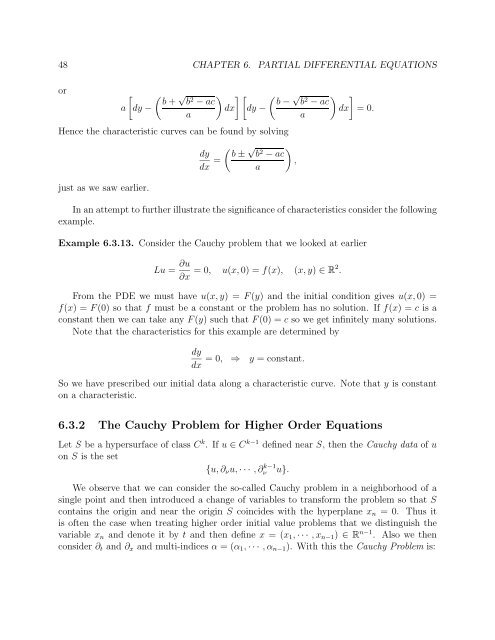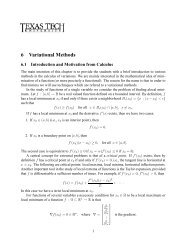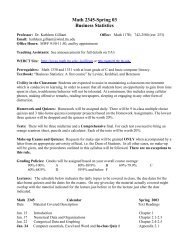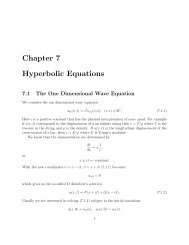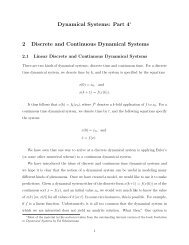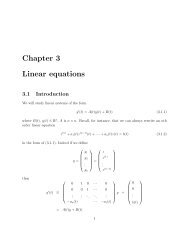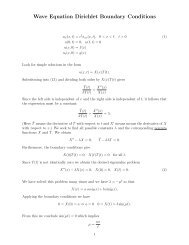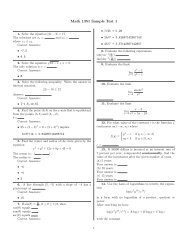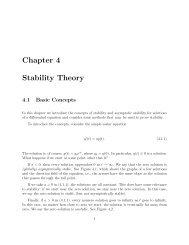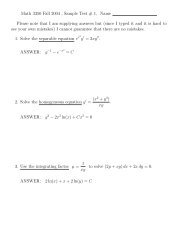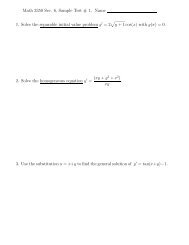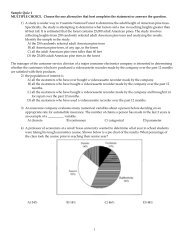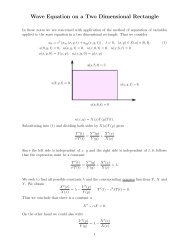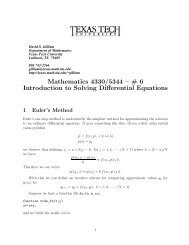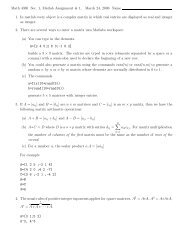Chapter 6 Partial Differential Equations
Chapter 6 Partial Differential Equations
Chapter 6 Partial Differential Equations
Create successful ePaper yourself
Turn your PDF publications into a flip-book with our unique Google optimized e-Paper software.
48 CHAPTER 6. PARTIAL DIFFERENTIAL EQUATIONS<br />
or<br />
[ ( √ ) ][ ( √ ) ]<br />
b + b2 − ac<br />
b − b2 − ac<br />
a dy −<br />
dx dy −<br />
dx =0.<br />
a<br />
a<br />
Hence the characteristic curves can be found by solving<br />
( √ )<br />
dy b ±<br />
dx = b2 − ac<br />
,<br />
a<br />
just as we saw earlier.<br />
In an attempt to further illustrate the significance of characteristics consider the following<br />
example.<br />
Example 6.3.13. Consider the Cauchy problem that we looked at earlier<br />
Lu = ∂u<br />
∂x =0, u(x, 0) = f(x), (x, y) ∈ R2 .<br />
From the PDE we must have u(x, y) =F (y) and the initial condition gives u(x, 0) =<br />
f(x) =F (0) so that f must be a constant or the problem has no solution. If f(x) =c is a<br />
constant then we can take any F (y) such that F (0) = c so we get infinitely many solutions.<br />
Note that the characteristics for this example are determined by<br />
dy<br />
dx<br />
=0, ⇒ y = constant.<br />
So we have prescribed our initial data along a characteristic curve. Note that y is constant<br />
on a characteristic.<br />
6.3.2 The Cauchy Problem for Higher Order <strong>Equations</strong><br />
Let S be a hypersurface of class C k .Ifu ∈ C k−1 defined near S, then the Cauchy data of u<br />
on S is the set<br />
{u, ∂ ν u, ··· ,∂ν<br />
k−1 u}.<br />
We observe that we can consider the so-called Cauchy problem in a neighborhood of a<br />
single point and then introduced a change of variables to transform the problem so that S<br />
contains the origin and near the origin S coincides with the hyperplane x n =0. Thusit<br />
is often the case when treating higher order initial value problems that we distinguish the<br />
variable x n and denote it by t and then define x =(x 1 , ··· ,x n−1 ) ∈ R n−1 . Also we then<br />
consider ∂ t and ∂ x and multi-indices α =(α 1 , ··· ,α n−1 ). With this the Cauchy Problem is:


